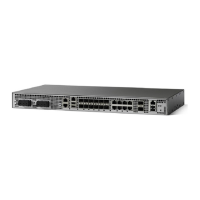Local LDP Identifier:
10.131.159.251:0
Discovery Sources:
Interfaces:
GigabitEthernet0/0/0 (ldp): xmit/recv
LDP Id: 10.131.159.252:0
FastEthernet1/0/0 (ldp): xmit/recv
LDP Id: 10.131.191.251:0
The show mpls ldp discovery command output shows thatGigabitEthernet0/0/0, which connects PE2 to P2,
is sending and receiving packets.
If a no mpls ip command is entered on GigabitEthernet0/0/0, this could prevent an LDP session between the
P2 and PE2 devices from being established. A show mpls ldp discovery command entered on the PE device
shows that the MPLS LDP session with the PE2 device is down:
Device# show mpls ldp discovery
Local LDP Identifier:
10.131.159.251:0
Discovery Sources:
Interfaces:
GigabitEthernet0/0/0 (ldp): xmit
FastEthernet1/0/0 (ldp): xmit/recv
LDP Id: 10.131.191.251:0
If the MPLS LDP session to PE2 goes down, the LSP to 10.131.159.252 becomes untagged, as shown by the
show mpls forwarding-table command:
Device# show mpls forwarding-table 10.131.159.252
Local Outgoing Prefix Bytes tag Outgoing Next Hop
tag tag or VC or Tunnel Id switched interface
19 Untagged
10.131.159.252/32 864 Et0/0 10.131.159.230
Untagged cases would provide an MPLS LSP Traceroute reply with packets tagged with No Label, as shown
in the following display:
Device# trace mpls ipv4 10.131.159.252/32
Tracing MPLS Label Switched Path to 10.131.159.252/32, timeout is 2 seconds
Codes: '!' - success, 'Q' - request not transmitted,
'.' - timeout, 'U' - unreachable,
'R' - downstream router but not target
Type escape sequence to abort.
0 10.131.191.230 MRU 1500 [Labels: 20 Exp: 0]
R 1 10.131.159.226 MRU 1500 [Labels: 19 Exp: 0] 80 ms
R 2 10.131.159.229 MRU 1504 [No Label] 28 ms
! 3 10.131.159.230 40 ms
MPLS LSP Ping and Traceroute Returns a Q
The Q return code always means that the packet could not be transmitted. The problem can be caused by
insufficient memory, but it probably results because a label switched path (LSP) could not be found that
matches the Forwarding Equivalence Class (FEC), information that was entered on the command line.
The reason that the packet was not forwarded needs to be determined. To do so, look at the Routing Information
Base (RIB), the Forwarding Information Base (FIB), the Label Information Base (LIB), and the MPLS Label
Forwarding Information Base (LFIB). Lack of an entry for the FEC in any one of these routing/forwarding
bases would return a Q.
The table below lists commands that you can use for troubleshooting when the MPLS echo reply returns a Q.
MPLS Basic Configuration Guide, Cisco IOS XE Everest 16.5.1 (Cisco ASR 900 Series)
94
MPLS LSP Ping, Traceroute, and AToM VCCV
ICMP ping and trace Commands and Troubleshooting

